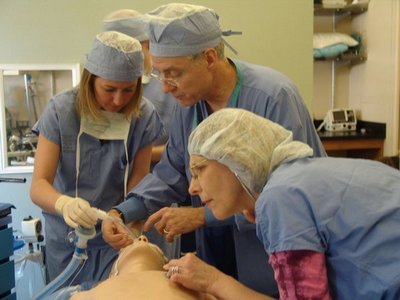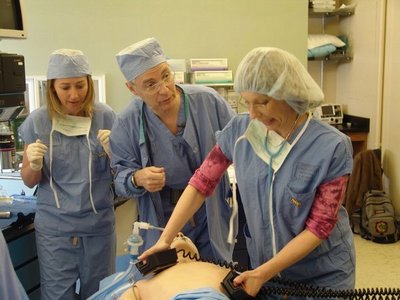July 6, 2006
ISIS: Where medicine meets virtual reality
Tina Wood and Laura Foy, co-hosts of Microsoft’s online technology program The Ten Show, are about to find out what happens when a patient’s heart stops beating in the OR.
The monitor above the patient, a male named “Chris,” shows an ominous flat line moving across the screen where his heartbeat had been visible just moments before. The medical team is busy administering CPR and charging the electronic paddles they hope will shock him back to life.
“Clear!” shouts the attending physician as the paddles jolt the patient’s body upward and a medical resident resumes CPR. Slowly, a heartbeat returns and the flat line transforms into a series of small waves — steady blips that travel across the monitor.
“Wow, that was intense,” Wood said, removing her face mask and looking down at Chris, whose heart is now beating normally. “I’m actually sweating.”
Fortunately, in this case, Chris is not a real patient but a mannequin, an electronic instructional device known in medical training as a simulator. Connected by a cable to a computer terminal in an adjacent room, he comes with software that enables him to mimic the symptoms of dozens of medical conditions. In many ways, Chris looks and behaves like a real person: he metabolizes drugs, his eyes blink, and his chest rises and falls as he breathes. You can even feel his pulse.
Chris is part of the UW’s Institute for Surgical and Interventional Simulation (ISIS) in the School of Medicine, a pioneer in the use of simulation technologies to improve the quality of health-care education and patient safety and outcomes.
As co-hosts of Microsoft’s online show, Wood and Foy travel across the country in search of stories about new technologies that are changing the world. They recently came to campus for an up-close look at ISIS and how medical simulation technologies are revolutionizing the way medicine is taught today.
While Foy prepared to observe Chris and the medical team from a computer screen in the next room, Wood joined Dr. Brian Ross, a UW Medicine anesthesiologist and director of ISIS, in the “sim lab,” a virtual OR that is nearly identical to a real operating room.
“Here we can teach residents how to manage events — critical events — that may happen to their patients during surgery that they may never encounter in their training,” Ross explained.
The benefit, Ross said, is students, interns and residents can practice a procedure “over and over and get very good at it — before trying it out on a real patient for the first time.”
Surgical techniques are not the only type of medical simulation. ISIS has faculty from 15 clinical specialties and from bioengineering, computer science, education, business, psychology and the Human Interface Technology Laboratory, where patients are immersed in virtual worlds as a way to treat phobias or provide distraction during painful therapies.
Next year, ISIS will move to UW Medical Center’s Surgery Pavilion, where the institute will occupy a 3,000-square-foot comprehensive training center. And, as the only medical school serving the five-state WWAMI region (Washington, Wyoming, Alaska, Montana and Idaho), the UW School of Medicine has plans to offer ISIS training throughout the region via its telemedicine network and, eventually, as an “ISIS on the Road” mobile training delivery system.
“I think this is probably my favorite segment that we’ve done,” Wood said when it was time to change out of her scrubs and pack up the video equipment. “It was so intense. I just feel like we should all group hug.”
Impressed with the hands-on learning experience, both Wood and Foy admitted they have a new respect for medical students.
The American College of Surgeons plans to accredit and establish a network of regional comprehensive skill training centers. The college is currently reviewing the ISIS application for certification as a Level I Comprehensive Education Institute and a decision is expected later this month. ISIS is one of the first of eight simulation centers in the United States and Canada now being considered for the certification.
- Coming up on The Ten Show:
- Dr. David Baker’s Rosetta@home project, a scientific research project that uses Internet-connected computers to predict and design protein structures and interactions.
- The Bio-Molecular Imaging Center at UW Medicine Lake Union and the new Philips Achieva 3T Whole Body Scanner that will be geared toward animal, human and translational research.
- Dr. Chuck Murry’s research on the use of stem cells to regenerate heart muscle.
- Dr. Hunter Hoffman’s Human Interface Technology (HIT) Lab and recent advances in virtual reality to help treat patients.


